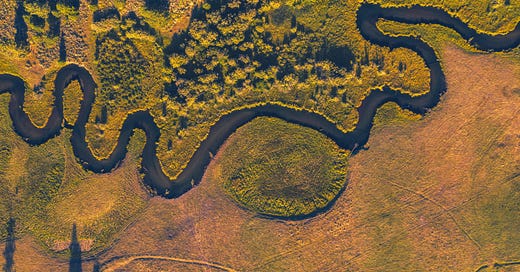Photo by Dan Meyers on Unsplash
Bioregionalism is a philosophy that suggests that political, cultural, and economic systems are more sustainable and just if they are organized around naturally defined areas called bioregions.
Bioregions are geographical areas defined by distinct ecological systems, plant and animal species, soils and landforms, human settlements and cultures, and topographic features such as watersheds. Bioregions can of course spill across political boundaries.
If you think about it, human societies were arranged around bioregions for most of human history, it is in the relatively recent history of humanity that we started dividing into states, and even then, many of our borders respect bioregion lines of rivers, mountains, oceans and lakes.
Bioregionalism is a growing movement to again organize in bioregions in order to protect them and regenerate them, thereby protecting ourselves and addressing the issues of climate change and overshoot that are coming for us.
The appeal of bioregionalism - at least to me - is that it focuses on the familiar and the local and is therefore more likely to spur action than a global problem that is abstract to most people, such as climate change, deforestation, biodiversity loss, or any other planetary boundaries. If more people knew about and cared for their bioregions, those that spoil our rivers, lakes, mountains and oceans would have a harder time doing so.
Throughout human history we had to take care of these resources, because they took care of us. Now, most of us live in cities and suburbs where we have separated ourselves from nature, so we don’t feel the need to take care of it.
Most of us go into nature every once in a while, but we don’t feel ownership of it so we don’t protect it.
How do I get involved?
The first step is to know where the hell you are. The good folks at One Earth have a great Navigator that helps you find your bioregion. Give it a testdrive: Navigator | One Earth
There are 185 bioregions around the Earth. I found out that I live in the Appalachia & Allegheny Interior Forests (NA24) bioregion.
You can take it a step further and learn what watershed you live in. The entire world is wade up of . A watershed is a drainage basin. Your watershed could be pretty small, making it easier to get involved in cleaning up and regenerating. I could only find watershed information in the US, but here is an easy tool. Find Watersheds
I’m in the Rivanna watershed.
One you know your bioregion and your watershed, you can look up local groups looking to protect your bioregion and watershed or start one yourself.
If you are looking for a place to learn more about bioregioning, you could do worse than r.3.0 (r3.0 | Redesign for Resilience & Regeneration for a green, inclusive and open economie).
Here’s what they say they do in their own words:
r3.0 promotes Redesign for Resilience and Regeneration. As a global common good not-for-profit platform, r3.0 crowdsources open recommendations for necessary transformations across diverse fields and sectors, in response to the ecological and social collapses humanity is experiencing, in order to achieve a thriving, regenerative and distributive economy and society.
You can learn a lot and find people and events under their bioregioning tab. I’ll just leave that here and let you surf:
Go where the money is.
Some smart folks are trying to marry the money with the message of bioregioning, and have started the The BioFi Project: Bioregional Finance for Planetary Regeneration. These folks are trying to establish more BFFs - not Best Friends Forever - but Bioregional Financing Facilities. They want to help create bioregioning banks, funds, venture capital and other resources to help bioregional thrive. Yes, the people at BioFi are already BFFs with the r3.0 people.
If you want to find out more, you can read the book Bioregional Financing Facilities by Samantha Power and Leaon Seefeld. The link is just above on the BioFi project link.
It’s a great gift for that person in finance or business who wants to save the world, but doesn’t know how to do it.
There is a BioFI community you can join at Hylo if interested
https://www.hylo.com/groups/biofi
Here’s the plan.
Start local. Get involved in protecting your bioregion and your watershed, and invite friends, family and mortal enemies to do the same. Once enough of us know the link between our bioregions and our survival, it gets harder to ignore the problems in our bioregions and assume someone else will take care of it.
A good analogy is renting vs. owning. If you own something, you take better care of it. If you just rent it, you don’t. How well did you look after that first apartment you rented. How well do you take care of the home you own now (if you own a home … essay for another day). Collectively we act like renters of nature because we assume someone else is taking care of it.
They aren’t.
If enough people own their bioregion, they will fight like hell to protect it.
So go out and own your bioregion.





Thanks, Matt. I have only recently come across bioregioning (Nate Hagens https://youtu.be/e08dWgk-TRo?si=p70reenEunUzv_WR) and in the UK there is an organisation called The Bioregional Learning Centre (bioregion.org.uk). There are resources there for determining UK watersheds. Water, of course, is foundational to our existence and the practice of extraction from underground sources for domestic and commercial purposes is a largely hidden problem. It makes sense to put this at the centre of our actual and metaphorical landscape and was I understand mooted as the basis of state lines when these were being decided.